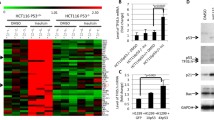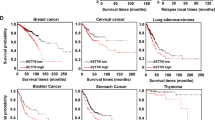Abstract
Dual-specificity phosphatase 5 (DUSP5), a VH1-like enzyme that hydrolyses nuclear substrates phosphorylated on both tyrosine and serine/threonine residues, has a potential role in deactivation of mitogen- or stress-activated protein kinases. Using cDNA-microarray technology, we found that the expression of DUSP5 mRNA was dramatically increased by exogenous p53 in U373MG, a p53-mutant glioblastoma cell line. Transcription of DUSP5 was also remarkably activated by endogenous p53 in response to DNA damage in colon-cancer cells (p53+/+) that contained wild-type p53, but not in p53−/− cells. Chromatin-immunoprecipitation (ChIP) and reporter assays demonstrated that endogenous p53 protein would bind directly to the promoter region of the DUSP5 gene, implying p53-dependent transcriptional activity. Overexpression of DUSP5 suppressed the growth of several types of human cancer cells, in which Erk1/2 was significantly dephosphorylated. If, as the results suggest, DUSP5 is a direct target of p53, it represents a novel mechanism by which p53 might negatively regulate cell-cycle progression by downregulating mitogen- or stress-activated protein kinases.





Similar content being viewed by others
References
Brondello JM, Pouyssegur J and McKenzie FR . (1999). Science, 286, 2514–2517.
el-Deiry WS, Kern SE, Pietenpol JA, Kinzler KW and Vogelstein B . (1992). Nat. Genet., 1, 45–49.
Furuhata T, Tokino T, Urano T and Nakamura Y . (1996). Oncogene, 13, 1965–1970.
Guan KL and Butch E . (1995). J. Biol. Chem., 270, 7197–7203.
Hollstein M, Sidransky D, Vogelstein B and Harris CC . (1991). Science, 253, 49–53.
Iiizumi M, Arakawa H, Mori T, Ando A and Nakamura Y . (2002). Cancer Res., 62, 1246–1250.
Ishibashi T, Bottaro DP, Michieli P, Kelley CA and Aaronson SA . (1994). J. Biol. Chem., 269, 29897–29902.
Kim TI, Jin SH, Kang EH, Shin SK, Choi KY and Kim WH . (2002). Ann. N. Y. Acad. Sci., 973, 241–245.
Ko LJ and Prives C . (1996). Genes Dev., 10, 1054–1072.
Kovanen PE, Rosenwald A, Fu J, Hurt EM, Lam LT, Giltnane JM, Wright G, Staudt LM and Leonard WJ . (2002). J. Biol. Chem., 278, 5205–5213.
Levine AJ . (1997). Cell, 88, 323–331.
Martell KJ, Kwak S, Hakes DJ, Dixon JE and Trent JM . (1994). Genomics, 22, 462–464.
Marti F, Krause A, Post NH, Lyddane C, Dupont B, Sadelain M and King PD . (2001). J. Immunol., 166, 197–206.
McGrory WJ, Bautista DS and Graham FL . (1988). Virology, 163, 614–617.
Miyashita T and Reed JC . (1995). Cell, 80, 293–299.
Mori T, Anazawa Y, Matsui K, Fukuda S, Nakamura Y and Arakawa H . (2002a). Neoplasia, 4, 268–274.
Mori T, Anazawa Y, Iiizumi M, Fukuda S, Nakamura Y and Arakawa H . (2002b). Oncogene, 21, 2914–2918.
Ng CC, Koyama K, Okamura S, Kondoh H, Takei Y and Nakamura Y . (1999). Genes Chromosomes Cancer, 26, 329–335.
Nishimori H, Shiratsuchi T, Urano T, Kimura Y, Kiyono K, Tatsumi K, Yoshida S, Ono M, Kuwano M, Nakamura Y and Tokino T . (1997). Oncogene, 15, 2145–2150.
Ochi K, Mori T, Toyama Y, Nakamura Y and Arakawa H . (2002). Neoplasia, 4, 82–87.
Oda K, Arakawa H, Tanaka T, Matsuda K, Tanikawa C, Mori T, Nishimori H, Tamai K, Tokino T, Nakamura Y and Taya Y . (2000). Cell, 102, 849–862.
Okamura S, Arakawa H, Tanaka T, Nakanishi H, Ng CC, Taya Y, Monden M and Nakamura Y . (2001). Mol. Cell, 8, 85–94.
Ono K, Tanaka T, Tsunoda T, Kitahara O, Kihara C, Okamoto A, Ochiai K, Takagi T and Nakamura Y . (2000). Cancer Res., 60, 5007–5011.
Oren M . (1994). Semin. Cancer Biol., 5, 221–227.
Shiraishi K, Fukuda S, Mori T, Matsuda K, Yamaguchi T, Tanikawa C, Ogawa M, Nakamura Y and Arakawa H . (2000). Cancer Res., 60, 3722–3726.
Stefanovsky VY, Pelletier G, Hannan R, Gagnon-Kugler T, Rothblum LI and Moss T . (2001). Mol. Cell, 8, 1063–1073.
Takei Y, Ishikawa S, Tokino T, Muto T and Nakamura Y . (1998). Genes Chromosomes Cancer, 23, 1–9.
Tanaka H, Arakawa H, Yamaguchi T, Shiraishi K, Fukuda S, Matsui K, Takei Y and Nakamura Y . (2000). Nature, 404, 42–49.
Tokino T, Thiagalingam S, el-Deiry WS, Waldman T, Kinzler K W and Vogelstein B . (1994). Hum. Mol. Genet., 3, 1537–1542.
Urano T, Nishimori H, Han H, Furuhata T, Kimura Y, Nakamura Y and Tokino T . (1997). Cancer Res., 57, 3281–3287.
Yoo J, Park SY, Robinson RA, Kang SJ, Ahn WS and Kang CS . (2002). Arch. Pathol. Lab. Med., 126, 1096–1100.
Author information
Authors and Affiliations
Corresponding author
Rights and permissions
About this article
Cite this article
Ueda, K., Arakawa, H. & Nakamura, Y. Dual-specificity phosphatase 5 (DUSP5) as a direct transcriptional target of tumor suppressor p53. Oncogene 22, 5586–5591 (2003). https://doi.org/10.1038/sj.onc.1206845
Received:
Revised:
Accepted:
Published:
Issue Date:
DOI: https://doi.org/10.1038/sj.onc.1206845
- Springer Nature Limited
Keywords
This article is cited by
-
Combined absence of TRP53 target genes ZMAT3, PUMA and p21 cause a high incidence of cancer in mice
Cell Death & Differentiation (2024)
-
An Update on Potential Molecular Biomarkers of Dietary Phytochemicals Targeting Lung Cancer Interception and Prevention
Pharmaceutical Research (2023)
-
BAF53A drives colorectal cancer development by regulating DUSP5-mediated ERK phosphorylation
Cell Death & Disease (2022)
-
Molecular characterization of early breast cancer onset to understand disease phenotypes in African patients
Medical Oncology (2022)
-
Loss of TACC1 variant25 inducing cell proliferation and suppressing autophagy in head and neck squamous carcinoma
Cell Death Discovery (2021)




